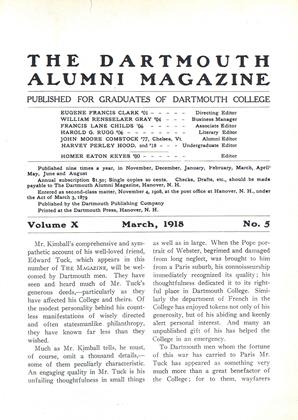The accompanying chart has been prepared to show certain interesting facts revealed by an analysis of the enrollment of the Military Stores School which was organized by the Tuck School shortly after the declaration of war, and which has since been conducted in a series of sessions, each of six weeks' duration. Forty universities and colleges are represented as sources of the enrollment of the five sessions already completed. From the five sessions more than 300 men have graduated into government service, the greater number of them to serve in the vast organization for the supply of the nation's fighting forces. Due to the lack of complete data, the figures showing the grades of men in the several branches entered are in a few cases only approximately accurate. But the exhibit indicates clearly enough that the men have given good account of themselves in service.
An enlarged, chart might also show that graduates of the course were in the first contingents of American troops transported to France, and that the number in overseas service has since been largely increased. An exhibit of equal interest might be made by showing the distribution of the men scattered among various cantonments, depots and stations, at each point rendering a service which events since April last show to be as vital to success in war, as exacting in its requirements, and as scientific in its technique as any other element of the organization for war.
The School had its origin in a call issued in May by the Storage Committee of the Council of National Defense and addressed to a number of schools of business administration. Recognizing at once the need for thousands of men trained for the exacting demands of the supply arms of the military forces, the Storage Committee, whose services will some day be seen to have been as notable as they have been heralded, took this means of creating the personnel soon to be required at the countless points where impending avalanches of war materials must be stored. The call was strongly supported by both the Ordnance and Quartermaster Departments of the Army, and in each of these bureaus officers were designated to cooperate with the schools. The instructional facilities of the Tuck School were immediately offered, the first session of the Military Stores School being opened on May 7th.
During the second and third sessions, instruction was offered for the storage service of both the Ordnance and Quartermaster Departments; latterly the sessions have been devoted exclusively to training for Ordnance field service, and are now conducted under the War Department with the official designation of Ordnance Training School, Dartmouth College. Standard courses and materials of instruction, developed in detail by the Ordnance Department and closely co-ordinated with the further training which the men receive at an arsenal or camp, constitute the curriculum. Lieut. Myron J. Files, Ordnance Reserve Corps, and Ordnance Sergeant Stuart S. Wall are detailed by the War Department, the former as Officer-in-Charge, and the latter as Assistant.
Men accepted for the School are enlisted or inducted into military service, are equipped, and with the grade of privates are assigned on six-week furloughs for instruction at Dartmouth College. During the period of further training and active service at an arsenal or cantonment, men are selected for promotion to non-commissioned grade. After three months in the service, they are eligible for consideration for commissions upon recommendation of commanding officers.
Whether it is because the School has been exceptionally fortunate in the selection of its enrollment or whether six weeks of Hanover have inspired them to conspicuous accomplishment, there is abundant evidence that through the spirit and quality of their work the men who have gone out from the several sessions have everywhere earned the frank praise of their commanders and have proportionately brought credit to Dartmouth. There is satisfaction, too, in the thought that sons of half a hundred colleges may in years to come recall kindly the college that helped them toward doing their bits in the war of redemption.
STATISTICS OP GRADUATES OP THE MILITARY SIORES SCHOOLCOLLEGES REPRESENTED AND BRANCHES OP SERVICE ENTERED
STATISTICS OF GRADUA COLLEGES REPRESESTEI
W. R. Gray, '04, Acting Director, The Amos Tuck School
 View Full Issue
View Full Issue
More From This Issue
-
 Article
ArticleCOLLEGE NEWS
March 1918 -
 Article
ArticleEDWARD TUCK '62
March 1918 By Benjamin A. Kimball '54 -
 Article
ArticleMr. Kimball's comprehensive and sympathetic account of his well-loved friend,
March 1918 -
 Sports
SportsBASEBALL
March 1918 -
 Books
BooksAlsace-Lorraine Under German Rule
March 1918 By FRANK MALOY ANDERSON -
 Class Notes
Class NotesCLASS SECRETARIES
March 1918










